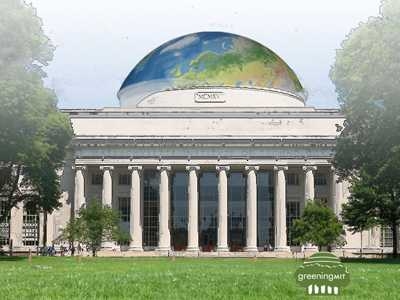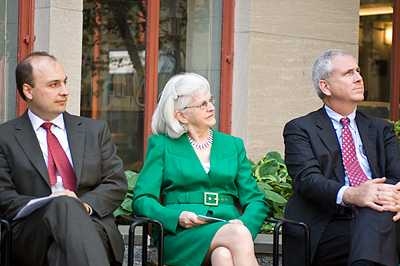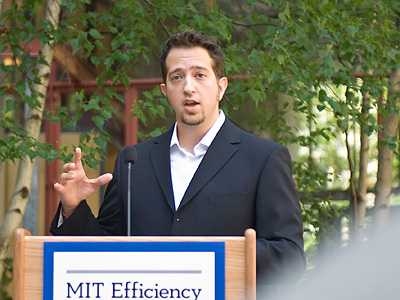In what could serve as a model for achieving large-scale energy-efficiency improvements, MIT and Boston-based utility NSTAR on Wednesday announced an ambitious collaboration that aims to slash the Institute’s electricity use by 15 percent over the next three years.
The program, “MIT Efficiency Forward,” is expected to save MIT $50 million in energy costs over the next decade by incorporating a portfolio of energy-saving projects and approaches, including sustainable new construction, major equipment retrofits, behavior-change programs, electric and gas incentives and experimentation with new technologies. While the goal is for MIT to save at least 34 million kilowatt-hours — equivalent to the yearly amount of electricity consumed by more than 4,500 Massachusetts homes — by 2013, NSTAR officials said they expect the Institute will exceed that mark.
“We are hoping this is really the first step, not only for MIT, but for other institutions and corporations throughout Massachusetts,” said Joseph R. Nolan, Jr., NSTAR senior vice president of customer and corporate relations. In addition to contributing more than $1.5 million to the approximately $13 million program, NSTAR will provide energy-efficiency tools and expertise to assist MIT.
MIT Efficiency Forward marks the largest efficiency project in NSTAR’s history and is meant to advance the Green Community Act that Massachusetts Gov. Deval Patrick signed in July 2008. Under the law, utility companies must offer significantly more rebates and other incentives for customers to upgrade lighting, air conditioning and industrial equipment to more efficient systems whenever those incentives cost less than the cost to generate the electricity to power the less-efficient equipment.
Susan Coakley of Northeast Energy Efficiency Partnerships, a nonprofit that facilitates partnerships to advance energy efficiency in the Northeast, said MIT Efficiency Forward’s three-year goal to reduce consumption by 15 percent was both “aggressive” and “achievable.” She said the goal was in line with that of other major research institutions and universities such as Princeton University, which is working to reduce overall utility usage on campus by at least 25 percent over the next 10 years.
Living laboratory
MIT Efficiency Forward builds on work developed and coordinated by the Campus Energy Task Force, which was launched by the MIT Energy Initiative (MITEI) in 2006 to reflect the Institute’s commitment to efficiency, innovation, cutting carbon emissions and energy usage and to serve as a model for other universities. By treating MIT’s campus as a living laboratory for research, educational and learning opportunities, the task force has helped MIT “walk the talk” on energy and sustainability.
With more than 200 Institute faculty currently working on energy-related research, energy is part of “the fabric of MIT research and education,” said Vladimir Bulovic, an associate professor in the Department of Electrical Engineering and Computer Science. The NSTAR collaboration will take that a step further by providing new teaching opportunities for students.
Just as students play an integral role in the task force, so, too, will they be heavily involved in MIT Efficiency Forward. A student advisory group will help devise outreach and awareness strategies, research project opportunities and approaches to measure, monitor and verify energy savings. “One particular option will be to assign teams of freshman and sophomores in analyzing energy conservation and efficiency options, recommending how they can be framed most effectively and monitoring the outcomes as part of project-based curriculum development,” said Donald Lessard, a professor in the MIT Sloan School of Management and a co-chair, with Bulovic, of MITEI’s Energy Education Task Force. MIT Efficiency Forward will also develop opportunities for students to collaborate with faculty and staff on research topics that can support the program’s goals through the Undergraduate Research Opportunities Program (UROP).
MIT Executive Vice President and Treasurer Theresa M. Stone said measuring and verifying the energy savings will be a hallmark of the program. She said the Institute would develop new approaches to measure energy reduction and would share them with other institutions, organizations and regulatory authorities.
The Campus Energy Task Force has invested about $3 million in energy-efficiency measures since 2006, and Stone said that the NSTAR collaboration will advise the Institute on how to maximize such efforts by reinvesting the accrued savings in other campus energy-efficiency projects.
How the goal will be met
About half of the expected 34-million kwh reduction will result from changes in lighting made across half of the MIT campus, some of which have already occurred in the Stata Center and in the Stratton Student Center. According to Peter Cooper, manager of sustainability engineering and utility planning at the Department of Facilities, these changes include shutting off lights when people don’t need them, dimming lights in certain spaces and changing lighting fixtures to ones that are more effective at reflecting light. Cooper also hopes to implement LED (light-emitting diode) bulbs, which last longer and use less energy than incandescent bulbs, in some locations.
About a third of the electricity savings will result from changes to various heating, ventilation and air conditioning (HVAC) systems, such as reducing the speed of the ventilation fans at night. Upgrades to both the lighting and HVAC systems are currently underway at Hayden Memorial Library.
The remaining savings will result from behavior-change programs, such as student-driven energy-efficiency campaigns, and sustainable construction techniques being implemented in new buildings, such as those that will house the Koch Institute for Integrative Cancer Research and the MIT Sloan School of Management, Cooper said. Both of those buildings are slated to open within the next year.
In addition to MIT Efficiency Forward, the Institute is seeking to reduce greenhouse gas emissions through combined heat and power generation, comprehensive waste minimization and recycling, renewable-power systems, alternative-fuel campus vehicles and extensive commuter-benefit programs.
Additional reporting by David L. Chandler
The program, “MIT Efficiency Forward,” is expected to save MIT $50 million in energy costs over the next decade by incorporating a portfolio of energy-saving projects and approaches, including sustainable new construction, major equipment retrofits, behavior-change programs, electric and gas incentives and experimentation with new technologies. While the goal is for MIT to save at least 34 million kilowatt-hours — equivalent to the yearly amount of electricity consumed by more than 4,500 Massachusetts homes — by 2013, NSTAR officials said they expect the Institute will exceed that mark.
“We are hoping this is really the first step, not only for MIT, but for other institutions and corporations throughout Massachusetts,” said Joseph R. Nolan, Jr., NSTAR senior vice president of customer and corporate relations. In addition to contributing more than $1.5 million to the approximately $13 million program, NSTAR will provide energy-efficiency tools and expertise to assist MIT.
MIT Efficiency Forward marks the largest efficiency project in NSTAR’s history and is meant to advance the Green Community Act that Massachusetts Gov. Deval Patrick signed in July 2008. Under the law, utility companies must offer significantly more rebates and other incentives for customers to upgrade lighting, air conditioning and industrial equipment to more efficient systems whenever those incentives cost less than the cost to generate the electricity to power the less-efficient equipment.
Susan Coakley of Northeast Energy Efficiency Partnerships, a nonprofit that facilitates partnerships to advance energy efficiency in the Northeast, said MIT Efficiency Forward’s three-year goal to reduce consumption by 15 percent was both “aggressive” and “achievable.” She said the goal was in line with that of other major research institutions and universities such as Princeton University, which is working to reduce overall utility usage on campus by at least 25 percent over the next 10 years.
Living laboratory
MIT Efficiency Forward builds on work developed and coordinated by the Campus Energy Task Force, which was launched by the MIT Energy Initiative (MITEI) in 2006 to reflect the Institute’s commitment to efficiency, innovation, cutting carbon emissions and energy usage and to serve as a model for other universities. By treating MIT’s campus as a living laboratory for research, educational and learning opportunities, the task force has helped MIT “walk the talk” on energy and sustainability.
With more than 200 Institute faculty currently working on energy-related research, energy is part of “the fabric of MIT research and education,” said Vladimir Bulovic, an associate professor in the Department of Electrical Engineering and Computer Science. The NSTAR collaboration will take that a step further by providing new teaching opportunities for students.
Just as students play an integral role in the task force, so, too, will they be heavily involved in MIT Efficiency Forward. A student advisory group will help devise outreach and awareness strategies, research project opportunities and approaches to measure, monitor and verify energy savings. “One particular option will be to assign teams of freshman and sophomores in analyzing energy conservation and efficiency options, recommending how they can be framed most effectively and monitoring the outcomes as part of project-based curriculum development,” said Donald Lessard, a professor in the MIT Sloan School of Management and a co-chair, with Bulovic, of MITEI’s Energy Education Task Force. MIT Efficiency Forward will also develop opportunities for students to collaborate with faculty and staff on research topics that can support the program’s goals through the Undergraduate Research Opportunities Program (UROP).
MIT Executive Vice President and Treasurer Theresa M. Stone said measuring and verifying the energy savings will be a hallmark of the program. She said the Institute would develop new approaches to measure energy reduction and would share them with other institutions, organizations and regulatory authorities.
The Campus Energy Task Force has invested about $3 million in energy-efficiency measures since 2006, and Stone said that the NSTAR collaboration will advise the Institute on how to maximize such efforts by reinvesting the accrued savings in other campus energy-efficiency projects.
How the goal will be met
About half of the expected 34-million kwh reduction will result from changes in lighting made across half of the MIT campus, some of which have already occurred in the Stata Center and in the Stratton Student Center. According to Peter Cooper, manager of sustainability engineering and utility planning at the Department of Facilities, these changes include shutting off lights when people don’t need them, dimming lights in certain spaces and changing lighting fixtures to ones that are more effective at reflecting light. Cooper also hopes to implement LED (light-emitting diode) bulbs, which last longer and use less energy than incandescent bulbs, in some locations.
About a third of the electricity savings will result from changes to various heating, ventilation and air conditioning (HVAC) systems, such as reducing the speed of the ventilation fans at night. Upgrades to both the lighting and HVAC systems are currently underway at Hayden Memorial Library.
The remaining savings will result from behavior-change programs, such as student-driven energy-efficiency campaigns, and sustainable construction techniques being implemented in new buildings, such as those that will house the Koch Institute for Integrative Cancer Research and the MIT Sloan School of Management, Cooper said. Both of those buildings are slated to open within the next year.
In addition to MIT Efficiency Forward, the Institute is seeking to reduce greenhouse gas emissions through combined heat and power generation, comprehensive waste minimization and recycling, renewable-power systems, alternative-fuel campus vehicles and extensive commuter-benefit programs.
Additional reporting by David L. Chandler








